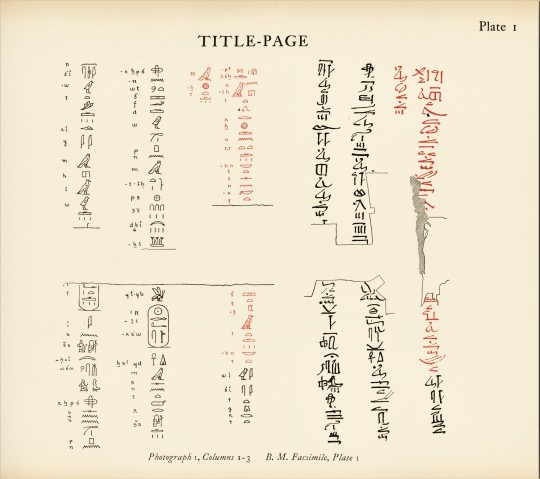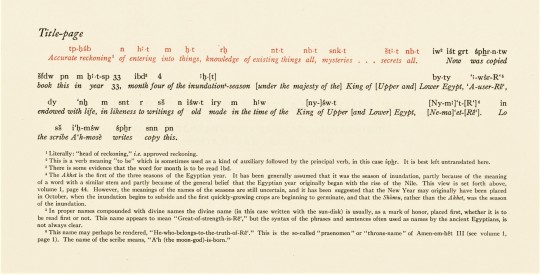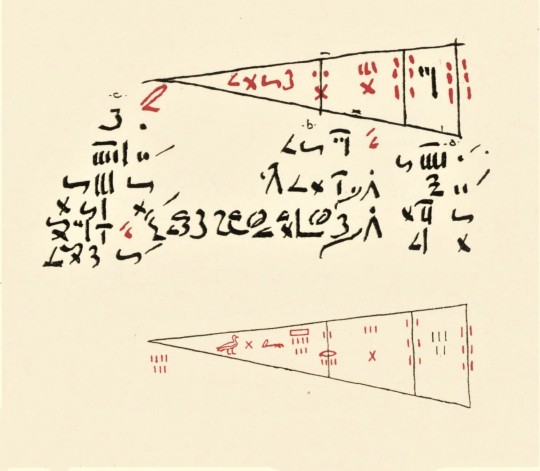#August Eisenlohr
Photo










An Egyptian Mathematics Science Saturday
While Archimedes of Syracuse (287-212 BCE) is often considered the first to calculate the value of Pi (π), the Egyptians got pretty darn close a millennium and a half or so earlier, as evidenced by the Rhind Mathematical Papyrus. Copied by the scribe Ahmes sometime around 1650 BCE from an earlier text, the papyrus gives us a remarkable insight not only into Egyptian mathematics but also customs and culture, from taxation and farming practices to the exchange rate between beer and bread. It is named after Scottish antiquarian Alexander Henry Rhind, who acquired the papyrus sometime around 1858. Held by the British Museum since 1865, it is now suspected that the papyrus entered the antiquities market as a result of illegal excavations.
Our facsimile of the papyrus was the result of fifteen years of scholarship by mathematician Arnold Buffum Chace. The first volume was published in Oberlin, Ohio by the Mathematical Association of America in 1927, with the second volume following in 1929. All of the above images are from the second volume, which contains photographs of the papyrus, as well as transcription transliterations and literal translations by Chace. Chace was assisted in his work by mathematician Henry Parker Manning and Egyptologist Ludlow Seguine Bull. Also included in the second volume is a supplement to the “Bibliography of Egyptian Mathematics” from the first volume, both of which were prepared by Raymond Clare Archibald.
The first publication of the Rhind Papyrus was a translation into German in 1877 by August Eisenlohr. The Mathematical Association of America publication was part if a flurry of new scholarship surrounding the papyrus following advancements in scholarly understanding of Egyptian writing. In the preface to our edition, Chace notes the important 1923 translation by Eric Peet published by Liverpool University Press. Chace remarks that “Egyptologists ... will find philological matters fully discussed by Professor Peet,” while he intended for his work to be geared towards both mathematicians and the general public.
Both volumes were originally donated to the Library of the State Teachers College Milwaukee by the Carnegie Corporation of New York with their bookplate.
Check out more Science Saturday posts here.
-Olivia, Special Collections Graduate Intern
#Science Saturday#Rhind Papyrus#Rhind Mathematical Papyrus#Ahmes#Ahmose#Alexander Henry Rhind#Arnold Buffum Chace#Arnold Chace#Mathematical Association of America#Henry Parker Manning#Ludlow Seguine Bull#Raymond Archibald#August Eisenlohr#Eric Peet#Mathematics#Mathematics in Antiquity#Antiquities#Papyrus#olivia
34 notes
·
View notes
Photo




Read in June
Not pictured:
Aryanti, Tutin. “Vision and Gendered Space: Making Women Invisible in Yogyakarta Sultanate Palace.” Space and Culture 20, no. 3 (August 1, 2017): 301–14.
Bauman, Richard. “Indirect Indexicality, Identity, Performance: Dialogic Observations.” Journal of Linguistic Anthropology 15, no. 1 (June 1, 2005): 145–50.
Bucholtz, Mary. “Sociolinguistic Nostalgia and the Authentication of Identity.” Journal of Sociolinguistics 7, no. 3 (2003): 398–416.
Coupland, Nikolas. “Language, Situation, and the Relational Self: Theorizing Dialect-Style in Sociolinguistics.” In Style and Sociolinguistic Variation, edited by Penelope Eckert and John R Rickford, 185–210. Cambridge, UK: Cambridge University Press, 2001.
Crow, Graham, and Rose Wiles. “Managing Anonymity and Confidentiality in Social Research: The Case of Visual Data in Community Research.” NCRM Working Paper Series. ESRC National Centre for Research Methods, n.d.
Eisenlohr, Patrick. “Materialities of Entextualization: The Domestication of Sound Reproduction in Mauritian Muslim Devotional Practices.” Journal of Linguistic Anthropology 20, no. 2 (2010): 314–333.
Elewa, Ahmed, and Laury Silvers. “‘I Am One of the People’: A Survey and Analysis of Legal Arguments on Woman-Led Prayer in Islam.” Journal of Law and Religion 26, no. 1 (2010): 141–71.
Elster, Charles A. “Authority, Performance, and Interpretation in Religious Reading: Critical Issues of Intercultural Communication and Multiple Literacies.” Journal of Literacy Research 35, no. 1 (2003): 663–692.
Fishman, Joshua A. “A Decalogue of Basic Theoretical Perspectives for a Sociology of Language and Religion.” In Explorations in the Sociology of Language and Religion, edited by Tope Omoniyi and Joshua A. Fishman, 13–25. Amsterdam: J. Benjamins, 2000.
Goodman, Jane E., Matt Tomlinson, and Justin B. Richland. “Citational Practices: Knowledge, Personhood, and Subjectivity.” Annual Review of Anthropology 43, no. 1 (2014): 449–63.
Grace, André P., and Fiona J. Benson. “Using Autobiographical Queer Life Narratives of Teachers to Connect Personal, Political and Pedagogical Spaces.” International Journal of Inclusive Education 4, no. 2 (2000): 89–109.
Hoffmann‐Dilloway, Erika. “Linguistic Anthropology in 2017: It Could Be Otherwise.” American Anthropologist 120, no. 2 (2018): 278–90.
Kroskrity, Paul V. “Narrative Reproductions: Ideologies of Storytelling, Authoritative Words, and Generic Regimentation in the Village of Tewa.” Journal of Linguistic Anthropology 19, no. 1 (2009): 40–56.
Kuipers, Joel. “Evidence and Authority in Ethnographic and Linguistic Perspective.” Annual Review of Anthropology 42, no. 1 (2013): 399–413.
Mishra, Smeeta, and Faegheh Shirazi. “Hybrid Identities: American Muslim Women Speak.” Gender, Place & Culture 17, no. 2 (April 1, 2010): 191–209.
Nespor, Jan. “Anonymity and Place in Qualitative Inquiry.” Qualitative Inquiry 6, no. 4 (December 1, 2000): 546–69.
Omoniyi, Tope. “Societal Multilingualism and Multifaithism: A Sociology of Language and Religion Perspective.” In Explorations in the Sociology of Language and Religion, edited by Tope Omoniyi and Joshua A. Fishman, 121–40. Amsterdam: J. Benjamins, 2000.
Omoniyi, Tope, and Joshua A. Fishman. “Introduction, Part I.” In Explorations in the Sociology of Language and Religion, edited by Tope Omoniyi and Joshua A. Fishman, 1–4. Amsterdam: J. Benjamins, 2000.
Ortner, Sherry B. “Theory in Anthropology since the Sixties.” Comparative Studies in Society and History 26, no. 1 (1984): 126–166.
Pennycook, Alastair. “‘The Rotation Gets Thick. The Constraints Get Thin’: Creativity, Recontextualization, and Difference.” Applied Linguistics 28, no. 4 (2007): 579–96.
Rahemtulla, Shadaab. “Toward a Genuine Congregation: The Form of the Muslim Friday Prayer, Revisited.” In Liturgy in Postcolonial Perspectives, 33–44. Postcolonialism and Religions. New York: Palgrave Macmillan, 2015.
Rosowsky, Andrey. “Religious Classical Practice: Entextualisation and Performance.” Language in Society 42, no. 3 (June 2013): 307–30.
Shah, Sarah, Gabriel A. Acevedo, and Andrea Liza Ruiz. “Contextualizing Events in Imagined Communities: Pre- and Post-September 11th Egyptian Attitudes toward Non-Arabs and Jews.” Sociology of Islam 5, no. 4 (December 5, 2017): 249–77.
Silvers, Laury. “Islamic Jurisprudence, ‘Civil Disobedience’, and Woman-Led Prayer.” In The Columbia Sourcebook of Muslims in the United States, edited by Edward E. Curtis VI, 246–52. New York: Columbia University Press, 2008.
Spolsky, Bernard. “Introduction, Part 2.” In Explorations in the Sociology of Language and Religion, edited by Tope Omoniyi and Joshua A. Fishman, 4–10. Amsterdam: J. Benjamins, 2000.
———. “Religion as a Site of Language Contact.” Annual Review of Applied Linguistics 23 (2003): 81–94.
2 notes
·
View notes